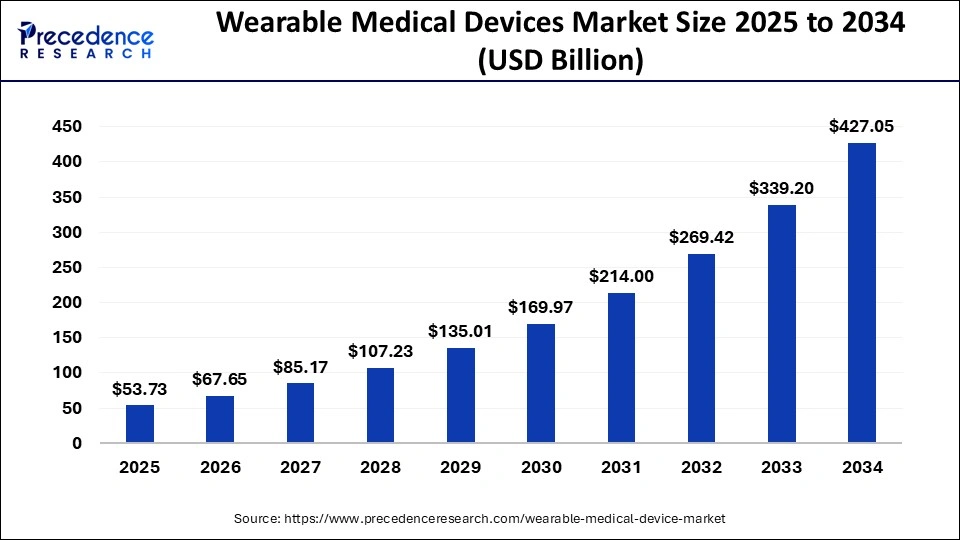Wearable Medical Devices Market Size to Reach USD 427.05 billion by 2034
Wearable Medical Devices Market Size to Reach USD 427.05 billion by 2034
The wearable medical devices market size accounted for USD 42.68 billion in 2024 and it is predicted to reach over USD 427.05 billion by 2034 at a CAGR of 25.9%.

Get Sample Copy of Report@https://www.precedenceresearch.com/sample/1131
Key Points
- With over 39% of the revenue share, North America led the market in 2024.
- The diagnostic devices segment emerged as the top product category, contributing 63% of total revenue.
- The home healthcare segment recorded the largest application share, accounting for 54% of the market.
Read Also: https://www.newsgazzete.com/in-vitro-diagnostics-market/
Market Scope
| Report Coverage | Details |
| Market Size in 2024 | USD 42.68 Billion |
| Market Size in 2025 | USD 53.73 Billion |
| Market Size by 2034 | USD 427.05 Billion |
| Growth Rate from 2025 to 2034 | CAGR of 25.9% |
| Largest Market | North America |
| Base Year | 2024 |
| Forecast Period | 2025 to 2034 |
| Segments Covered | Site, Product, Application |
| Regional Scope | North America, APAC, Europe, Latin America, MEAN, Rest of the World |
Market Dynamics
Market Drivers
The wearable medical devices market is experiencing rapid growth due to the increasing adoption of smart healthcare solutions. The demand for real-time monitoring of vital signs, coupled with the rise in lifestyle-related diseases, is fueling the need for wearable health technologies.
Continuous innovations in biosensors, Bluetooth-enabled medical devices, and cloud-based health data storage are enhancing the efficiency of wearable medical devices. Additionally, the COVID-19 pandemic has accelerated interest in remote monitoring solutions, further driving market demand.
Opportunities
The expansion of wearable medical technology into specialized healthcare areas such as neurology, respiratory monitoring, and maternal health is creating new growth opportunities. The introduction of flexible and skin-adherent wearable devices is improving patient comfort and usability.
The increasing adoption of blockchain technology for secure health data management is expected to enhance consumer trust in wearable medical devices. Furthermore, the growing trend of integrating wearables with mobile health apps and electronic health records is opening new possibilities for personalized healthcare.
Challenges
One of the key challenges in the market is ensuring seamless interoperability between wearable devices and existing healthcare systems. Many wearable medical devices still face connectivity issues, affecting data transmission and usability.
Cybersecurity threats and concerns about unauthorized access to personal health data continue to be a major concern for consumers. Additionally, limited awareness and trust in wearable medical devices among older populations may slow down market penetration.
